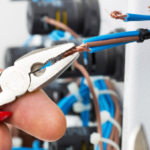Electrical Installation Domestic
The whole process of connecting accessories for distribution of electricity to various appliances and home equipment is known as electrical installation domestic installation. It covers the phases of design, conduits and fittings cabling, termination, and design.
 Cables transmit electricity to the switches or receptacles. They are available in a variety of sizes depending on the way in which the circuit cross-section is to be connected to the appliance.
Cables transmit electricity to the switches or receptacles. They are available in a variety of sizes depending on the way in which the circuit cross-section is to be connected to the appliance.
Wiring
The wires connecting different appliances and equipment comprise the wiring of a electrical installation in the home. These wires are usually run underground or in the walls and ceilings. These lines must be run safely and correctly by an electrician to ensure they don’t ignite or malfunctioning devices that are powered by them.
Electrical wiring in homes is usually regulated by local and national codes. These codes define security standards for electrical installations in the construction. They also regulate the type of wire or cable that is employed.
In addition to these safety standards wires must also be sized to accommodate the circuits powered by it. This is crucial because a wire that is too small could cause overloading of circuits and cause malfunctioning or overheating.
There are a variety of sizes of wires utilized in the electrical wiring of a home. They can also be insulated by various materials. For instance copper wires are coated with a variety materials, including Vulcanized Indian Rubber (VIR) or Lead-Aluminum alloy (95 percent Lead and 5% aluminum).
Insulated wires are then run through conduits or pipes. Conduit may be flexible or made of metal. The capacity to fill is the maximum number of wires that could traverse a conduit.
Non-metallic (NM), cable is the most widely used type of wire for electrical installations at home. It is comprised of two or more wires, wrapped inside a colored sheathing. They usually have one or more hot wires, as well as a neutral and ground wire.
Outlets
A vital part of your electrical wiring are the electrical outlets. They let you switch on lights, appliances, and more. They also safeguard you from electrocution. In addition, outlets help to make your home more energy-efficient.
Outlets are available in a variety of sizes and styles. They can be used for many uses. Selecting the right outlet for each room can make a huge difference to your safety, convenience and energy consumption.
There are two kinds of outlets: receptacles as well as lighting outlets. Receptacles are used to connect cords and plugs equipment and fuse box installation lighting outlets are intended to be plugged into lamps or fixtures that require direct wiring.
A 3 Phase electrical Installation-prong receptacle is by far the most well-known type of outlet in the United States. They have an additional ground wire and are more secure than outlets with two prongs. They are in compliance with all current building codes and recommended for light electrical usage in your house or office.
A switched outlet is another well-known type of outlet. This allows you to leave lamps or appliances connected even when they are not actually on this saves energy and makes it easier for you to control your electrical devices.
For ease of cleaning and maintenance, some homeowners prefer to install floor outlets in their homes. These are great for spaces where running cables from the wall can be unsafe or unattractive.
Many people prefer installing outlets with a built-in USB charging port for smartphones, tablets and other devices. These outlets don’t require an additional power cord and can be used in rooms with expensive appliances such as computers, TVs or refrigerators.
Switches
They regulate the flow of electricity by either opening or closing the connections between two wires. They are an essential element of an electrical installation domestic since they permit you to turn on or off the power to your appliances, lights and other appliances.
A single-pole light switch is one of the most frequently used switches in an electrical installation. It manages a single fixture from a single location. These switches are simple to install and come in a variety of styles and colors.
Make sure the switch you are installing has the correct amperage and voltage ratings for the circuit. If not, replace it with the correct size and rated type.
The switch opens or closes the connection between the black wire (the hot wire) and the white wire to regulate the flow of current through the circuit. When you turn the switch, current flows through the black wire to the light or receptacle, and then back to ground to complete the circuit.
You can change the state of an electrical connection in some switches by moving an actuator. This could be the form of a slide, a lever or a lever. Actuation is the mechanism that changes a connection’s state. It is crucial to choose the right actuator type for your application.
If you’re replacing a light switch, first disconnect the wires of the switch that was previously used and then remove the switch from the electrical box. The new switch needs to be connected to the wires by long-nose pliers or another method that wraps the wire around the terminal screw. Then , you can plug the switch inside the electrical box.
Circuit Breakers
Circuit breakers in an electrical installation domestic are switches which interrupt the flow of electricity when there is an issue. These switches are designed to protect against short circuits, as well as other safety hazards that could be a threat, such as fire and electric shock.
They function by detecting excess current or heat in the wiring and then cutting off the area of power. They are essential parts of electrical installations and should not be neglected when working on your home’s electrical system.
These devices are able to be manually switched from the service panel, but they also «trip» automatically when a safety hazard is detected. This includes short circuits, ground faults and arc fault conditions.
There are many types of circuit breakers. However, each one functions in the same way. They detect excess temperature or current, and then cut off the power supply until the problem can be resolved in a safe manner. Certain breakers can be reset, while others need to be replaced when they fail.
The simplest type of circuit breakers is low-voltage. They utilize a stored energy spring that throws the switch and then separates the contact from the circuit. These breakers let you manually cut off and reset power delivery with the flip of the switch.
Medium-voltage circuit breakers are usually bolted to a bus bar. They can be separated from the circuit with draw-out construction. This allows the removal of breaker without affecting the power connections. This allows electricians to add circuits or replace broken breakers.
These are the most widely used types of circuit breakers, and are found in both residential and commercial buildings. They can be classified by the amount of fault current that they can interrupt. They are a cheaper option over more advanced devices such GFCIs and Arc Fault Circuit Interrupters.
Self-Certification
A competent third party must be certified if planning to install an electrical system in your home. The work should be completed and tested in a safe manner that meets Part P of the Building Regulations.
If the electrical wiring in a house isn’t in compliance with the standards, there’s a risk of electric shock or even fire. This is why all work done and repairs to existing electrical systems should be examined and tested.
In many countries across Europe, it’s required that an electrician carries out tests to ensure the safety of electrical installations in the house. This certification is made through an array of tests that refer to a unified international standard.
These tests can be costly and time-consuming. These tests are essential for home safety and health.
There are several self-certification programs in the UK that allow qualified electricians self-certify that their work complies with BS 7571. These are available through the National Inspection Council for Electrical Installation Contracting (NICEIC) and the ECA.
The scheme requires that a self certifier has a valid business name and is covered by professional indemnity and public liability insurance, and has sufficient instruments to carry out the required tests. It also requires a record of test results and suitable installation work to prove conformance.
In Germany, for example, a ministerial decree from 1997 states that electrical installations be inspected and checked on a regular basis. Every new installation has to have an inspection report.
In Spain the same method is followed in Spain. Every new construction must be declared conformable. Industrial installations are exempt from the requirement to conduct periodic inspections every five years. But this doesn’t guarantee that an installation is completely compliant with the law.



